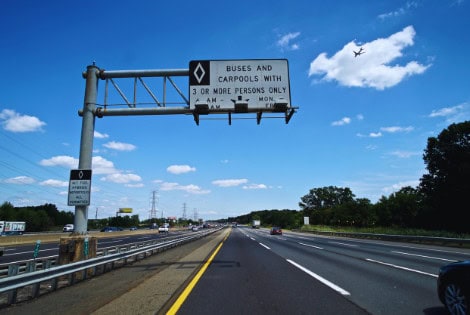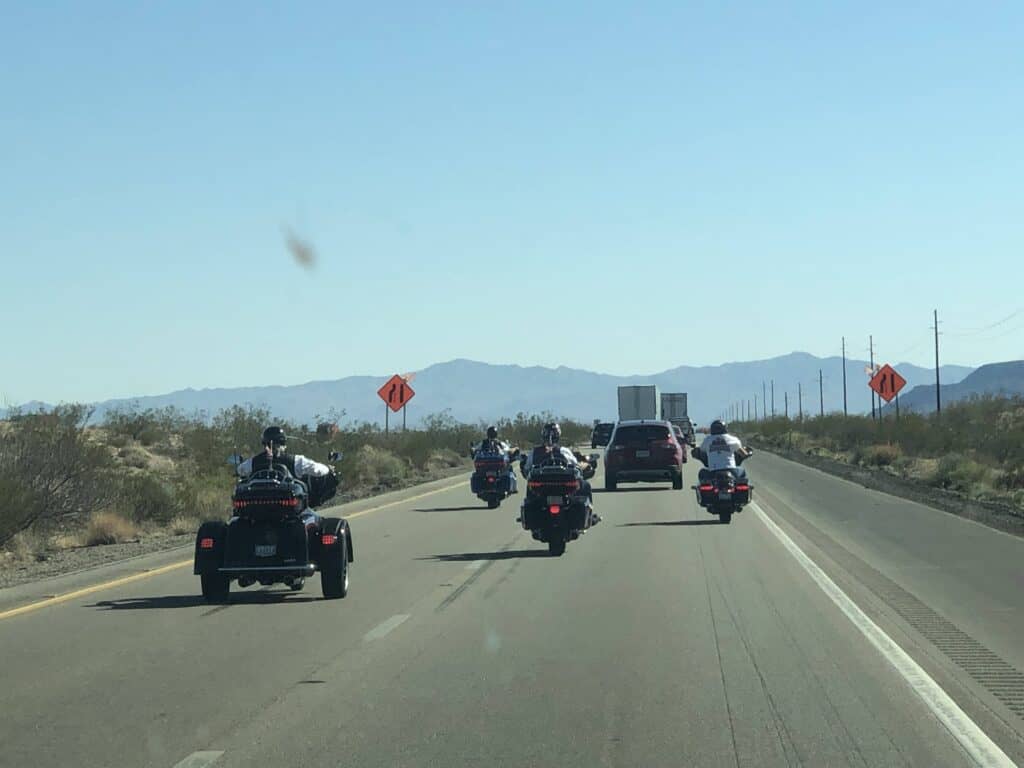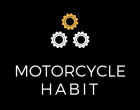
The HOV lane, which stands for High Occupancy Vehicle lane, is an express lane for vehicles with 2 or more passengers designed to promote ridesharing. The idea is to have more carpooling and reduce the overall number of vehicles on busy highways, especially during rush hour in metropolitan areas.
Can a motorcycle ride in the HOV lane? While there is commonly only one rider, motorcycles are allowed in the HOV lane in order to promote greater safety for motorcycle riders. While state DOT’s do have the authority to amend this rule, motorcycles are allowed in the HOV lane in most states in the U.S.
If you aren’t familiar with HOV lanes, you may be wondering why it’s worth knowing this. The primary reason to utilize the HOV lane while on a motorcycle is safety. Whether you are commuting or just passing through, the HOV lane is a great way to get around other commuters. Typically, the HOV lane will be nearly empty as compared to the other congested lanes.
Rules For Using The HOV Lane On A Motorcycle
Riding a motorcycle in the HOV lane follows the same traffic laws as other vehicles. I currently live in Utah where it is legal to use the HOV lane on a motorcycle and I use it often. Here are some tips I want you to remember when using the HOV lane.
First, there will be a lot of merging. By design, the HOV lane will be the furthest left lane. This will require several lane changes and often this can be dangerous. Always use turn signals and/or hand signals to keep other drivers alert. Take your time before merging and double-check your blind spots. In heavy traffic, this can be an ordeal, but getting over to the HOV lane is possible.
States regulate the HOV lane differently, but typically there are certain sections of the HOV lane for merging in. These sections are defined by having dashed white lines. Otherwise, there is a solid white line to separate the regular lanes and HOV lanes. Whether coming in or going out, crossing the solid line is illegal and can carry a fine.
For other vehicles, driving in the carpool/HOV lane as a single rider is illegal and comes with fines, which vary by state. In Washington State, the WSDOT implemented the HERO program to reduce solo drivers using the carpool lane.
Washington drivers who see a violation can call a number to report the concern. Violators are mailed information reminding them of the laws. According to the official website, Washington drivers violate this law about 5% less, on average, as compared to the national average.
Second, be aware of the speed limits. Typically, the HOV lane will have the same speed limit as the other traffic lanes. However, often if there is heavy traffic, the carpool lane will be fairly clear. This creates a differential in the speeds of traffic in each lane. While the speed limit remains the same, extra caution should be taken in case someone decides to jump out of traffic into the HOV.
The speed limit is regularly posted along the highway. Most GPS services include a display of the local speed limit. If it is unclear what the limit is, err on the side of caution while keeping up with the speed of the flow of traffic. Speeding is a huge risk and can have a hefty fine, so always obey the speed limit.
Finally, the HOV lane isn’t typically a toll road. While there are some provisions (depending on the state) for single drivers to use the HOV with a toll, this doesn’t apply to motorcyclists. However, be aware of where toll lanes are and anticipate the required toll.
Always follow the local traffic laws. It should be obvious that violating traffic laws puts all motorists at unnecessary risk. Fines are a stark reminder to not break the law but are a bit more manageable than going to court over violations.
Times When Motorcycles Shouldn’t Use The HOV Lane

Under typical conditions, especially during rush hour, the HOV lane is a safe way to travel that can save a bit of time. However, there are some conditions I’ve noticed while riding that you should consider in which it shouldn’t be used.
First, depending on the location, the HOV lane is only restricted at certain times of the day. If you happen to be traveling during a time where it is not restricted, you might not gain as much from it as the volume of traffic may be higher. Use discretion and stay safe during these times.
Similarly, depending on the state, the HOV lane can be reversible, meaning it can be used for traffic flowing in one direction, but then can be changed for traffic in the opposite direction. The flow direction is indicated and routed by using lighting and signs. In this case, a bike can still utilize the lane, but be aware that the direction can be different.
Second, if you will be on the highway for a couple of exits, it isn’t necessary to merge all the way over just to have to merge all the way back. As will be discussed below, merging across several lanes on a bike can be a bit risky, especially during heavy traffic.
Otherwise, there aren’t many reasons not to use the HOV lane. Be sure to know and follow local traffic laws and pay attention while sharing the road.
Tips For Safely Using The HOV Lane
According to the U.S. Department of Transportation and the Federal Highway Administration, the idea behind allowing motorcycles in the HOV lane is that it is safer to keep motorcycles moving instead of being in stop-and-go traffic. Even in the event of low traffic times when the HOV would be as safe as any other lane, it could still be worthwhile in case of a sudden change in traffic conditions.
During rush hour especially, drivers are more likely to have road rage. Since motorcycles are smaller and have lower visibility than larger vehicles, this makes for a dangerous combination. The HOV allows riders to bypass this and merge into much safer traffic.
Here are a few tips for safely using the HOV lane:
- Use turn signals when merging
- Check mirror and blind spot
- Use caution around merging zones, where applicable
- Yield to emergency vehicles
- Know and obey local traffic laws
Getting into the HOV lane is all about the merge. From the first merge onto the highway, there may be 3-5 lanes to cross to get into the HOV lane. Using turn signals–even using hand turning signals–will alert other drivers to merging traffic.
Getting over into the HOV lane often requires coming back from the HOV lane. Merging across all lanes of traffic to exit can be as much of a process and should be done cautiously. Know which exit to take and allow extra time to get over before the exit.
Along with signaling, be sure to check mirrors before actually merging. This ensures the lane is clear. An additional measure of safety is to quickly check blind spots by looking over the shoulder facing the merging lane. When done correctly, this provides the best assurance of a clear merging spot.
Adjacent traffic will likely be moving slower as compared to traffic in the HOV lane. This difference in speed poses a potential problem. A slower moving vehicle coming out of the regular lanes can be an obstruction to oncoming HOV traffic. To remedy this situation, simply pay attention to the surroundings and obey the speed limit.
Since the HOV lane is a quicker way around held-up traffic, it is often used for emergency vehicle access to accidents. This includes state troopers and other police officers, fire trucks, and ambulances. Wreckers and tow trucks also utilize this outside lane to help clear out vehicles. Paying attention to conditions and yielding as necessary is the best way to keep everyone safe.
Above all, the best way to be safe is to know and obey traffic laws. Anything from lane dividers, speed limits, on and off-ramp etiquette, and so on, will help all motorists stay safe. This can also include required safety equipment, primarily an up-to-date helmet. While accidents aren’t entirely avoidable, obeying the law is the best bet to keep the rubber side of your bike down.
Also, there is a low-emissions angle when it comes to HOV implementation. As mentioned, the HOV lane promotes carpooling and, in theory, this means fewer vehicles overall on the roadways. By having a lower volume of vehicles operating, there is a corresponding decrease in emissions, which is beneficial for air quality.
Some states allow low-emission vehicles to utilize HOV lanes to further promote air quality. While motorcycles aren’t necessarily low-emissions vehicles, the smaller displacement engines (as compared to a car engine) put out lower emissions by volume.
Conclusion
Motorcycles are allowed and even encouraged to utilize the HOV lane. This promotes safety for motorcyclists as they can keep moving during stopped traffic and also saves a bit of time typically. While there aren’t many specific rules to the HOV lane, cautiously merge and obey the speed limit. Yield to emergency vehicles that also utilize the HOV lane. Overall, these lanes are designed to promote better traffic flow, so take advantage. Ride safe everyone!
